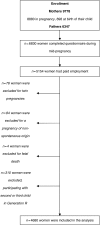Occupational exposure to chemicals and fetal growth: the Generation R Study
- PMID: 22215632
- PMCID: PMC3279127
- DOI: 10.1093/humrep/der437
Occupational exposure to chemicals and fetal growth: the Generation R Study
Abstract
Background: Developmental diseases, such as birth defects, growth restriction and preterm delivery, account for >25% of infant mortality and morbidity. Several studies have shown that exposure to chemicals during pregnancy is associated with adverse birth outcomes. The aim of this study was to identify whether occupational exposure to various chemicals might adversely influence intrauterine growth patterns and placental weight.
Methods: Associations between maternal occupational exposure to various chemicals and fetal growth were studied in 4680 pregnant women participating in a population-based prospective cohort study from early pregnancy onwards in the Netherlands (2002-2006), the Generation R Study. Mothers who filled out a questionnaire during mid-pregnancy (response: 77% of enrolment) were included if they conducted paid employment during pregnancy and had a spontaneously conceived singleton live born pregnancy (n = 4680). A job exposure matrix was used, linking job titles to expert judgement on exposure to chemicals in the workplace. Fetal growth characteristics were repeatedly measured by ultrasound and were used in combination with measurements at birth. Placental weight was obtained from medical records and hospital registries. Linear regression models for repeated measurements were used to study the associations between maternal occupational exposure to chemicals and intrauterine growth.
Results: We observed that maternal occupational exposure to polycyclic aromatic hydrocarbons, phthalates, alkylphenolic compounds and pesticides adversely influenced several domains of fetal growth (fetal weight, fetal head circumference and fetal length). We found a significant association between pesticide and phthalate exposure with a decreased placental weight.
Conclusions: Our results suggest that maternal occupational exposure to several chemicals is associated with impaired fetal growth during pregnancy and a decreased placental weight. Further studies are needed to confirm these findings and to assess post-natal consequences.
Figures




Similar articles
-
Physically demanding work, fetal growth and the risk of adverse birth outcomes. The Generation R Study.Occup Environ Med. 2012 Aug;69(8):543-50. doi: 10.1136/oemed-2011-100615. Epub 2012 Jun 27. Occup Environ Med. 2012. PMID: 22744766
-
Occupational chemical exposures in pregnancy and fetal growth: evidence from the Born in Bradford Study.Scand J Work Environ Health. 2020 Jul 1;46(4):417-428. doi: 10.5271/sjweh.3878. Epub 2020 Jan 23. Scand J Work Environ Health. 2020. PMID: 31970422 Free PMC article.
-
Exposure to Bisphenol A and Phthalates during Pregnancy and Ultrasound Measures of Fetal Growth in the INMA-Sabadell Cohort.Environ Health Perspect. 2016 Apr;124(4):521-8. doi: 10.1289/ehp.1409190. Epub 2015 Jul 21. Environ Health Perspect. 2016. PMID: 26196298 Free PMC article.
-
Review: Polycyclic aromatic hydrocarbons (PAHs)-Action on placental function and health risks in future life of newborns.Toxicology. 2019 Jan 1;411:133-142. doi: 10.1016/j.tox.2018.10.003. Epub 2018 Oct 13. Toxicology. 2019. PMID: 30321648 Review.
-
Perfluoroalkyl chemicals and human fetal development: an epidemiologic review with clinical and toxicological perspectives.Reprod Toxicol. 2009 Jun;27(3-4):212-230. doi: 10.1016/j.reprotox.2009.02.001. Epub 2009 Feb 20. Reprod Toxicol. 2009. PMID: 19429401 Review.
Cited by
-
The Endocrine Disruption of Prenatal Phthalate Exposure in Mother and Offspring.Front Public Health. 2020 Aug 28;8:366. doi: 10.3389/fpubh.2020.00366. eCollection 2020. Front Public Health. 2020. PMID: 32984231 Free PMC article. Review.
-
Questionnaire results on exposure characteristics of pregnant women participating in the Japan Environment and Children Study (JECS).Environ Health Prev Med. 2018 Sep 15;23(1):45. doi: 10.1186/s12199-018-0733-0. Environ Health Prev Med. 2018. PMID: 30219031 Free PMC article.
-
Chemical mixture that targets the epidermal growth factor pathway impairs human trophoblast cell functions.Toxicol Appl Pharmacol. 2024 Feb;483:116804. doi: 10.1016/j.taap.2024.116804. Epub 2024 Jan 6. Toxicol Appl Pharmacol. 2024. PMID: 38185387 Free PMC article.
-
First year growth in relation to prenatal exposure to endocrine disruptors - a Dutch prospective cohort study.Int J Environ Res Public Health. 2014 Jul 10;11(7):7001-21. doi: 10.3390/ijerph110707001. Int J Environ Res Public Health. 2014. PMID: 25014249 Free PMC article.
-
Maternal exposure to di-2-ethylhexylphthalate and adverse delivery outcomes: A systematic review.Reprod Toxicol. 2016 Oct;65:76-86. doi: 10.1016/j.reprotox.2016.07.002. Epub 2016 Jul 10. Reprod Toxicol. 2016. PMID: 27412369 Free PMC article.
References
-
- Altman DG, Chitty LS. New charts for ultrasound dating of pregnancy. Ultrasound Obstet Gynecol. 1997;10:174–191. - PubMed
-
- Axmon A, Rylander L. Birthweight and fetal growth in infants born to female hairdressers and their sisters. Occup Environ Med. 2009;66:198–204. - PubMed
-
- Bakker R, Steegers EA, Obradov A, Raat H, Hofman A, Jaddoe VW. Maternal caffeine intake from coffee and tea, fetal growth, and the risks of adverse birth outcomes: the Generation R Study. Am J Clin Nutr. 2010;91:1691–1698. - PubMed
-
- Barr DB, Bishop A, Needham LL. Concentrations of xenobiotic chemicals in the maternal–fetal unit. Reprod Toxicol. 2007;23:260–266. - PubMed
-
- Brouwers MM, van Tongeren M, Hirst AA, Bretveld RW, Roeleveld N. Occupational exposure to potential endocrine disruptors: further development of a job exposure matrix. Occup Environ Med. 2009;66:607–614. - PubMed
Publication types
MeSH terms
Substances
LinkOut - more resources
Full Text Sources
Medical

